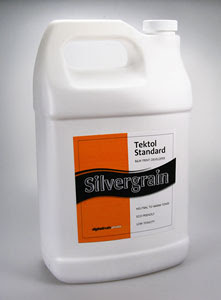As you might have guessed after spending a day in the dark room inhaling them, the chemicals used in photography are hardly friendly. Silver halide photography (pretty much the universal type of photography today) traditionally uses some pretty nasty chemicals. Developers, for instance, are generally combinations of hydroquinone and metol (metolquinone or M-Q developers) or hydroquinone and phenodine (P-Q developers). Hydroquinone is very toxic, and a suspected carcinogen. Prolonged exposure to hydroquinone causes fairly significant ocular damage. Metol is moderately toxic by skin or eye contact, or inhalation, and toxic by ingestion. Phenidone has similar toxicity levels.
They aren’t especially friendly to the environment, either. Irresponsible dumping of chemicals can cause lots of unwanted pollution. Remember, some of these chemicals are highly toxic. Replenisher can be used to prolong the lifespan of your chemicals. But once you need to get rid of them, do so responsibly. A great website with information on proper disposal of chemicals can be found here. Also, just dumping your unwanted prints and film isn’t good for the environment either, because of the high silver content of developed film and prints (those of you who know the chemistry of photography understand why this is).

Luckily for us, someone out there knew there’d be a market for “greener” chemicals. The company Silvergrain has effective developers, stop baths, and fixers. Four of the more toxic chemicals used in typical photography have been replaced in Silvergrain’s solutions. You can read more about it here; it sounds pretty promising. There's a discussion on replacing more harmful chemicals with these chemicals on photo.net here. The chemicals can be purchased here. On an environmental note, though, these chemicals are not sold in powder form, meaning they’ll use more fossil fuels to ship.
But what if I still want to buy my favorite chemicals? First of all, be sure to buy powdered and buy in bulk if you can!
Another good way to be “greener” (and save some money) is to use a water rinse instead of stop bath. This has the same effect as acid-based stop bath solutions, though it takes a bit longer. Why the same effect? The whole idea behind stop bath is stopping the reaction that goes on when film is exposed to developer. Neutralizing this alkaline (basic) reaction requires a non-basic wash, and for a long time that has meant using an acidic wash. Water, though, should have a neutral pH (check pH in your area, a more basic pH will take longer to neutralize the reaction) and thus be pretty much just as effective at stopping the reaction. A website I found tests this theory and finds the stopping time is extremely similar for both water and acid stop bath.
Health note: Because of the toxic nature of the traditional chemicals, good ventilation in your darkroom is key. The important thing is that there be airflow, across the floor and into an exhaust system, because you need to replace the air taken out by the exhaust system. This exhaust system should be close to where you’re using the chemicals, so it takes up the vapors. Ceiling-mounted vents don't really do much besides make noise. Hoods placed well above the chemical area only serve to suck chemical vapors up into your lungs and are generally ineffective at removing the vapors from the room (because they're meant to suck in vapors that rise up to them, like steam, and photographic chemical vapors don't do that). More information on this can be found here.
The bottom line is, photography CAN be made greener, but it isn’t in the interest of large companies to do so because the market now is in digital, not in traditional film photography. It’s easiest to keep doing photography the way we always have, but now that we better understand the health and environmental effects, changes can be made to make photography greener for those of us who are concerned about the environment but interested in continuing to do traditional photography.

1 comment:
Could you cover film processing as well?
Post a Comment